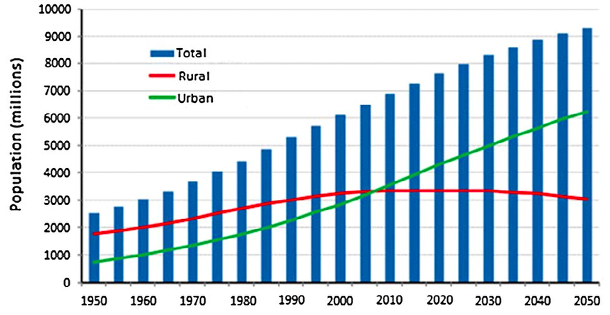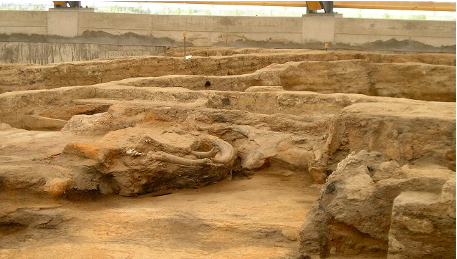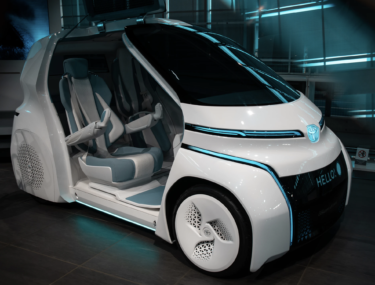はじめに
今回はTED-Edから「1万年にわたる都市化と都市の進化(Urbanization and the evolution of cities across 10,000 years)」と言う動画が気になって視聴してみた。世界の人口は都市により集中する傾向にあるけど、都市化が進むと出生率が低下すると言う。日本でも東京の出生率は低下しているけど地方では下げ止まりや反転現象も起きている。世界の人口や日本の人口はどこかで適正なレベルに落ち着くのだろうか。少子化問題については以前投稿したが、そんなことを考えながら視聴してみた。興味のある方はぜひトライして欲しい。
(出典:YouTube)
TO都市化
古代の社会では都市に住む人は少数だったけど、現在では世界人口の約半分は都市に住んでいる。都市には求心力が働く。人が集まることで政治、文化、経済、教育の中心として発達し、さらに人が集まる。都市に人が集まることで文化や文明が発達する。2050年には世界の人口が100億人に達すると言われ、しかもその約7割が都市部に集中する。しかし、都市化が進むことで都市部と地方での経済格差の問題や、都市部における環境破壊、各種インフラの整備や老朽化なども解決すべき課題である。

(出典:researchgate)
人口の推移と都市化との関係
日本では人口減少に歯止めがかからない。しかし、これは日本だけの問題ではないようだ。TFRとは、合計特殊出生率(Total Fertility Rate)の略であり、人口統計上の指標として15~49歳までの女性の年齢別出生率を合計したもので、一人の女性がその年齢別出生率で一生の間に産むとしたときの子供の人数に相当する。都市部に人口が集まるが、都市化が進むと出生率(TFR)が低下することはよく知られている。下のグラフは、比較的出生率が低い途上国の特性として、中国の全国及び省レベルのTFRの変化を検証したものだ。中国では、1979年に制定した一人っ子政策を緩和している。2014年には夫婦どちらかが一人っ子の場合に2人目の出産を認め、2016年すべての夫婦にそれを解禁し、2021年5月末には3人まで認める方針を発表した。これは将来に向けての急激な人口減少継続への危機感と、都市化が進むので人口抑制策を緩和しても短期的に人口増加が急激に発生しないという読みがあるようだ。

(出典:springer)
世界最古の都市
世界最古の都市はどこかには諸説があるようだ。一説にはメソポタミア南部において紀元前7,000年から6,500年ごろに初期の農耕や牧畜文化が成立して、集落の形成や定住化が進んだとされている(参考)。縄文時代の集落を考えると日本の古代都市も無視してはいけないと思う。
チャタルホユックの新石器時代遺跡
トルコのアナトリア地方にある「チャタルホユックの新石器時代遺跡」が、世界最古の都市遺跡とされる。その最下層は、紀元前7,500年にまで遡る。総人口では1万人ほどに達したとされており、人口変化を考慮しても、5,000人から8,000人ほどの人口と推測される。ライオンなどの猛獣や外敵の侵入を防ぐために家の出入り口は屋上についていて、屋根からあげれる背中あわせの家となっている。東側の遺跡は紀元前7,400年から6,200年にかけての新石器時代の18の階層が発掘されている。西側では、紀元前6,200年から5,200年までの金石併用時代の住居が発見されている。壁画やレリーフなど特徴的な遺物が存在し、新石器時代の初期の定住農業生活を記録した最も重要な人間居住区である。

(出典:skyticket)
三内丸山遺跡
紀元前5,900年から4,200年(縄文時代前期中頃から中期末葉)の青森県青森市の遺跡だ。江戸時代の頃から遺跡の存在は知られていた。当初は野球場を建設する計画だったが、遺跡の発掘調査が進み、地元住民が頑張って遺跡の保護の必要性と重要性をアピールして保護されることになった。本当に良かった。三内丸山遺跡(さんないまるやまいせき)は、1997年3月5日に国の特別史跡に指定され、2021年7月27日には、北海道・北東北の縄文遺跡群として世界文化遺産に登録された。遺跡には住居群、倉庫群のほか、シンボル的な3層の掘立柱建物が再現されている。ここから出土された遺物は段ボールで数万箱に及ぶ。土器や石器に加えて、日本最大の板状土偶などの土製品や石製品も出土している。また、黒曜石、琥珀、漆器、翡翠製大珠なども出土しており、当時の交易の証拠となっている。

(出典:三内丸山遺跡)
イスラエルの古代都市
イスライエルのエルサレムから西方向に5kmほどのモッツァ・ジャンクションの近くから、約9千年前に存在したとされる新石器時代の遺跡が発掘された。当時は約3,000人が暮らす古代都市とされる。公共施設、儀式用の場所、通路、植物の種子を納めた貯蔵庫などが発掘されている。さらには、狩りや戦闘に用いる矢尻、火打ち石などの道具、青銅器時代の槍の穂先もあった。なお、2019年10月7日のAFP通信では5,000年前の年遺跡と報じている。

(出典:古代都市)
8つの質問
Q1) In 3-4 sentences, discuss the importance of improvements in farming techniques to the development of cities.
論述問題だった。農業技術の向上が都市の発展に果たした重要性について述べよとある。人間が生きていくためには、食べ物が必要です。農業は食物を作ることである。農業技術は質・量ともに日進月歩で進化していると言う論旨で書いたが、もう少し深みのある文章を書きたいものだ。
Q2) Reliable food supplies allowed humans the luxury of free time, which provided the opportunity to produce items for trade. Describe how the production of goods contributed to the growth of cities.
これも論述だ。食糧の安定供給は、人間に自由な時間を与え、交易のための品物を生産する機会を提供した。物品の生産が都市の成長にどのように貢献したかを説明しなさいと言う設問だ。都市は人が集まる場所である。食料、水、家、布など、さまざまな種類の財を、ある人は要求し、ある人は提供する。だから、都市は、必要なものと種をマッチングさせるための非常に貴重な場所であると言う論旨で次のように書いた。
Q3) Experts predict that global population will top out around 10 billion people, with 7 billion of those people living in cities. What are some of the opportunities and challenges that cities will face as the population increases?
専門家の予測によると、世界の人口は100億人程度に達し、そのうち70億人は都市に住むと言われている。人口の増加に伴い、都市が直面する機会や課題にはどのようなものがあるかをと言う設問の論述だ。都市に住む世界人口が70億人になると、その都市で生活するためにはさまざまな課題が顕在化する。食料、水、家、衣服は生活に欠かせないものであり、人々が働き、学び、楽しみ、生活するためのインフラを支え、提供することが必要と言う論旨で書いたつもりだけど、まだまだだ。
Q4) What percentage of the human population lived in cities 100 years ago?
100年前には、人類の何パーセントの人が都市に住んでいたかと言う設問だ。答えは20%だった。
Q5) What led to the development of the first semi-permanent settlements?
最初の半永久的な居住地ができたきっかけは何かと言う設問だ。正直これは色々な答えがあると思ったけど、成果は農業の発達(Advances in agriculture)だった。
Q6) Which of the below technologies is a development that resulted from the desire to trade with neighboring communities?
近隣の地域との交易を望んだ結果、発展した技術は何かという設問だ。選択肢の中では道路(road)だけど、これ以外にもShipやportなどの技術も発達した。
Q7) Why were people initially drawn to cities?
なぜ、人々は当初、都市に引き寄せられたのかと言う設問だ。これも正直悩ましかったが、仕事にありつけるから(The availability of jobs)が正解だった。現在であれば、余暇の確保や、より安全な生活環境も正解かもしれないが、当時は労働力が不足していたし、都市にくれば稼げるという図式があったのだろう。
Q8) Global population is expected to top out at _______ billion people.
世界の人口は予想の設問だ。正解は100億人なので、10 billion peopleとなる。
まとめ
世界的に人々は都市部に住む人が増え、都市部に住む人が増えると出生率が低下する。かつてのローマやギリシャなどもこのような図式が適用されたのだろうか。1980年台にヨーロッパに旅行したときには、高齢者が多いと言うのが感想だった。しかし、現在では日本の方が高齢化が問題となっている。しかし、世代の交代が進めば、今度は中国の高齢化が深刻になるのだろ。世界の人口は 2064年に約97億人でピークを迎え、2100年には約88億人に減少するとの予測が出された(参考)。人類はこれまでも単調に人口が増加してきたわけではない。温暖化が進みすぎても環境破壊や異常気象、海進の問題があるが、逆に寒冷化が進むと直接的に食料不足の問題やエネルギー問題が生じる。現在の数百年、数千年が非常に恵まれた時期だったのだろうか。
以上
最後まで読んで頂きありがとうございました。
拝
参考:英文スクリプト
Today, more than half of all people in the world live in urban areas. By mid-century, this will increase to 70%. But as recently as 100 years ago, only two out of ten people lived in a city, and before that, it was even less. how have we reached such a high degree of urbanization, and what does it mean for our future? In the earliest days of human history, humans were hunter-gatherers, often moving from place to place in search of food. But about 10,000 years ago, our ancestors began to learn the secrets of selective breeding and early agricultural techniques. For the first time, people could raise food rather than search for it, and this led to the development of semi-permanent villages for the first time in history.
“Why only semi-permanent?” you might ask. Well, at first, the villages still had to relocate every few years as the soil became depleted. It was only with the advent of techniques like irrigation and soil tilling about 5,000 years ago that people could rely on a steady and long-term supply of food, making permanent settlements possible. And with the food surpluses that these techniques produced, it was no longer necessary for everyone to farm. This allowed the development of other specialized trades, and, by extension, cities. With cities now producing surplus food, as well as tools, crafts, and other goods, there was now the possibility of commerce and interaction over longer distances. And as trade flourished, so did technologies that facilitated it, like carts, ships, roads, and ports. Of course, these things required even more labor to build and maintain, so more people were drawn from the countryside to the cities as more jobs and opportunities became available. If you think modern cities are overcrowded, you may be surprised to learn that some cities in 2000 B.C. had population densities nearly twice as high as that of Shanghai or Calcutta.
One reason for this was that transportation was not widely available, so everything had to be within walking distance, including the few sources of clean water that existed then. And the land area of the city was further restricted by the need for walls to defend against attacks. The Roman Empire was able to develop infrastructure to overcome these limitations, but other than that, modern cities as we know them didn’t really get their start until the Industrial Revolution, when new technology deployed on a mass scale allowed cities to expand and integrate further, establishing police, fire, and sanitation departments, as well as road networks, and later electricity distribution. So what is the future of cities? The global population is currently more than 7 billion and is predicted to top out around 10 billion. Most of this growth will occur in the urban areas of the world’s poorest countries. So, how will cities need to change to accommodate this growth?
First, the world will need to seek ways to provide adequate food, sanitation, and education for all people. Second, growth will need to happen in a way that does not damage the land that provides us with the goods and services that support the human population. Food production might move to vertical farms and skyscrapers, rooftop gardens, or vacant lots in city centers, while power will increasingly come from multiple sources of renewable energy. Instead of single-family homes, more residences will be built vertically. We may see buildings that contain everything that people need for their daily life, as well as a smaller, self-sufficient city, focused on local and sustainable production. The future of cities is diverse, malleable, and creative no longer built around a single industry, but reflecting an increasingly connected and global world.




